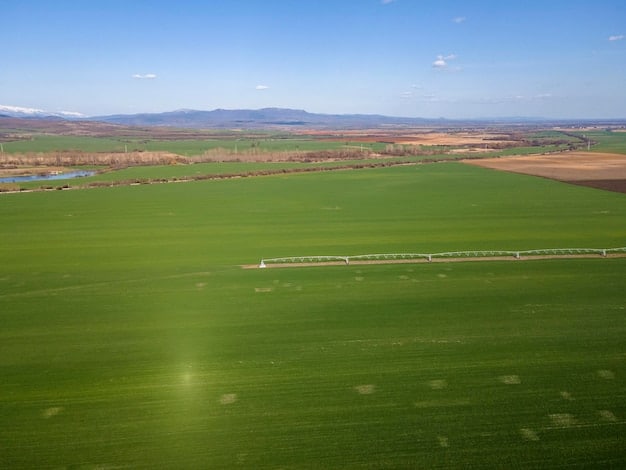Unlock Passive Income: Investing in Farmland for Long-Term Gains

Unlock Passive Income: Investing in Farmland for Long-Term Appreciation and Rental Income explores how purchasing agricultural land offers stable, long-term returns by combining property value appreciation with potential rental income from farming operations, making it a lucrative passive investment strategy, especially in the US.
Unlocking passive income streams can feel like finding a hidden treasure. What if that treasure was beneath your feet, rooted in the earth? Passive Income Unlocked: Investing in Farmland for Long-Term Appreciation and Rental Income is more than just a concept; it’s a tangible strategy for building wealth and security.
Unlocking Passive Income with Farmland Investing
Farmland, often overlooked in the world of investments, presents a unique opportunity for generating passive income. Understanding how to navigate this market can unlock a stable revenue stream and long-term financial security.
Let’s delve into the fundamentals of farmland investment and explore how it can be a powerful tool in your passive income strategy.

Why Farmland? The Allure of Agricultural Investments
Farmland offers several compelling advantages as an investment. Its inherent value, tied to essential food production, makes it relatively stable compared to more volatile assets.
Furthermore, it provides dual income streams: appreciation in land value and potential rental income.
Understanding the Dynamics of Farmland Value
Investing in farmland involves understanding several key factors that influence its value:
- Location: Proximity to markets, water resources, and favorable climate conditions all impact land value. Consider the accessibility and suitability of the location.
- Soil Quality: Fertile soil is crucial for productive farming. Soil tests and historical yields can provide valuable insights.
- Water Rights: Access to water is essential for irrigation. Investigate water rights and regulations in the area.
- Crop Suitability: Different regions are suited for different crops. Understanding local agricultural practices is vital.
Investing in farmland offers intrinsic value because the value is attached to food. There is always going to be the need for food, therefore, farmland provides a stable asset.
Navigating the Farmland Investment Landscape
Investing in farmland isn’t a one-size-fits-all approach. Various avenues are available, each with its own set of pros and cons.
Choosing the right method depends on your investment goals, risk tolerance, and capital.
Direct Land Ownership: Hands-On Approach
Direct ownership provides complete control over the land and its operations. However, it also requires significant capital and expertise.
Managing farming operations, or hiring someone to do so, is essential for generating rental income.
REITs and Farmland Funds: Diversified Exposure
Farmland REITs (Real Estate Investment Trusts) and funds offer a more passive approach to farmland investing:
- Lower Capital Requirements: Allows investors to participate with smaller investments.
- Diversification: Provides exposure to a portfolio of farmland properties, reducing risk.
- Professional Management: Fund managers handle the day-to-day operations and tenant management.
- Liquidity: REITs are often publicly traded, offering greater liquidity compared to direct ownership.
REIT’s are a great way to be diversified in farmland. Furthermore, they are managed by experts in the field, allowing you to generate passive income with less effort.

Maximizing Rental Income from Farmland
Rental income is a key component of the passive income potential of farmland. Optimizing rental agreements and tenant selection is crucial.
Understanding different leasing structures and their implications is essential for maximizing returns.
Leasing Structures: Finding the Right Fit
Several leasing structures are commonly used in farmland rentals, each with its own risk and reward profile:
- Cash Rent: The tenant pays a fixed amount per acre. Offers predictable income but doesn’t account for yield fluctuations.
- Sharecropping: The landlord and tenant share the crop yield and expenses. Provides higher potential returns but also higher risk.
- Hybrid Agreements: Combines elements of cash rent and sharecropping to balance risk and reward.
Each leasing structure provides pros and cons, however, if you don’t mind risking a bit of your profit for increased return, sharecropping might be the option for you.
Tenant Selection: Choosing the Right Partner
Selecting a reliable and experienced tenant is paramount. Consider the following factors:
- Farming Experience: A proven track record of successful farming practices.
- Financial Stability: The tenant’s ability to meet rental obligations.
- Reputation: Positive references from previous landlords and suppliers.
- Communication Skills: Open and transparent communication is essential for a successful partnership.
The tenant is crucial, so ensuring that they have a history in the niche and are reliable can create much more success for the partnership.
Long-Term Appreciation: The Patient Investor’s Reward
While rental income provides immediate returns, long-term appreciation is a major driver of wealth creation in farmland investing.
Factors like population growth, increasing food demand, and limited land availability contribute to rising farmland values.
The Role of Supply and Demand in Farmland Value
The fundamental principle of supply and demand plays a significant role in farmland appreciation:
- Limited Supply: The amount of arable land is finite, creating scarcity.
- Increasing Demand: Global population growth and rising food demand drive up land values.
- Inflation Hedge: Farmland tends to retain its value during inflationary periods, acting as a hedge against currency devaluation.
Farmland will continue to rise in value because of limited supply, and growing demand. This in turn provides great potential for appreciation.
Strategies for Maximizing Appreciation
While market forces drive overall appreciation, several strategies can enhance the value of your farmland:
- Land Improvement: Investing in irrigation systems, soil amendments, and drainage can increase productivity and value.
- Conservation Practices: Implementing sustainable farming practices can enhance soil health and long-term value.
- Strategic Location: Investing in areas with strong growth potential and infrastructure development.
Consider using strategies to maximize appreciation such as land improvement and conservation practices which in turn increase value
Risks and Mitigation Strategies in Farmland Investing
Like any investment, farmland comes with its own set of risks. Understanding and mitigating these risks is crucial for success.
Common challenges include weather-related risks, commodity price volatility, and regulatory changes.
Weather and Climate Risks: Nature’s Unpredictability
Weather events can significantly impact crop yields and farm income:
- Drought: Lack of rainfall can severely reduce crop production. Irrigation systems and drought-resistant crops can mitigate this risk.
- Flooding: Excessive rainfall can damage crops and erode soil. Proper drainage systems and flood insurance can help minimize losses.
- Extreme Temperatures: Heatwaves and frosts can harm crops. Selecting crops suitable for the local climate and implementing protective measures can reduce vulnerability.
Weather and climate risk, however, are uncontrollable. Consider irrigations systems and selecting drought resistant crops to potentially mitigate some of the risk.
Commodity Price Volatility: Riding the Waves
Commodity prices can fluctuate significantly, impacting farm income. Strategies to manage this risk include:
- Crop Diversification: Planting a variety of crops can reduce reliance on any single commodity.
- Hedging: Using futures contracts to lock in prices for future harvests.
- Crop Insurance: Protecting against losses due to low prices or crop failure.
Commodity price volatility can be managed by diversifying crops. Hedging, and crop insurance can reduce potential losses.
Due Diligence: Your Farmland Investment Checklist
Thorough due diligence is essential before investing in farmland. This involves a comprehensive assessment of the property, its potential, and associated risks.
Engaging experienced professionals, such as agricultural consultants and real estate attorneys, is highly recommended.
Key Areas of Due Diligence
Before committing to a farmland investment, consider the following:
- Title Search: Verify ownership and identify any liens or encumbrances on the property.
- Soil Testing: Assess soil fertility and identify any potential contamination.
- Water Rights Verification: Confirm access to sufficient water resources and associated rights.
- Environmental Assessment: Identify any environmental hazards or regulatory restrictions.
Completing thorough due diligence is import for a succesful investment. Consider also consulting an agricultural consultant to help with the process.
Assembling Your Due Diligence Team
Building a team of qualified professionals is crucial:
- Agricultural Consultant: Provides expertise on soil quality, crop suitability, and farming practices.
- Real Estate Attorney: Reviews legal documents, ensures proper title transfer, and advises on legal aspects of the transaction.
- Financial Advisor: Helps assess the investment’s financial viability and aligns it with your overall portfolio.
Having a strong team is crucial for maximum safety and probability of success. All professions listed provide value to your investment.
| Key Point | Brief Description |
|---|---|
| 🌱 Land Appreciation | Farmland value increases over time due to limited supply and rising demand. |
| 💸 Rental Income | Generate income by leasing your farmland to farmers. |
| 🛡️ Risk Mitigation | Diversify crops, get insurance and consider hedging to manage potential losses. |
| 🔎 Due Diligence | Thoroughly assess the property, soil, and legal aspects before investing. |
FAQ
▼
Farmland offers long-term appreciation due to its limited supply and increasing demand for food. It also provides rental income and acts as a hedge against inflation, making it a stable asset.
▼
You can lease your land to farmers through various structures, such as cash rent, where you receive a fixed payment, or sharecropping, where you share the crop yield and expenses.
▼
The major risks include weather-related issues like droughts and floods, commodity price volatility, and regulatory changes. Proper risk mitigation strategies are crucial.
▼
Due diligence ensures you assess the property thoroughly, including checking the title, testing the soil, verifying water rights, and reviewing environmental aspects to minimize risks.
▼
Yes, engaging professionals like agricultural consultants, real estate attorneys, and financial advisors is highly recommended to help with assessment, legal compliance, and financial planning.
Conclusion
Investing in farmland presents a compelling opportunity for generating passive income through long-term appreciation and rental yields. By understanding the market dynamics, navigating the various investment options, and implementing effective risk mitigation strategies, investors can unlock a stable and rewarding income stream. Conducting thorough due diligence and seeking professional guidance are essential steps toward successful farmland investing, ensuring a secure and profitable venture.





